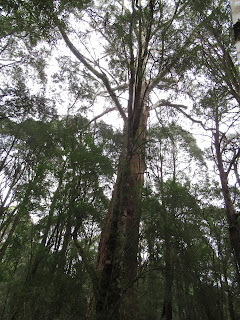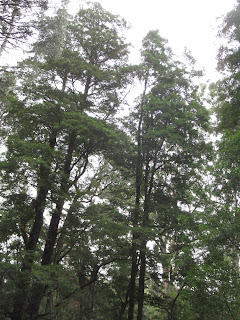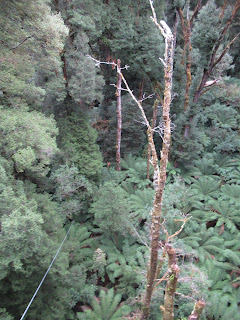I am simultaneously finishing a travel blog about the fantastic 4.5 month long trip Steven and I took last fall to Armenia, Georgia, Azerbaijan, and much of Central Asia before our final six weeks in Spain and Portugal and a few days in the Netherlands. If you're interested in checking that exciting adventure out, here's the link:
www.bergersadventures6.blogspot.com
Diane and I decided to get off the Great Ocean Road when it headed inland at Lavers Hill after hearing about the Otway Fly, the world's longest and highest tree-top walk that opened in 2003.
The Fly was built to provide an elevated walk through magnificent Myrtle Beech rainforest and Mountain Ash eucalyptus forest. It was situated on 225 acres of what was previously used for logging and farming. As a viable alternative to tree harvesting, it has paid for itself many times over, as well as providing a wonderful nature experience for visitors from all over the world.
Unlike any hike I've ever taken, there were fire hoses at regular intervals throughout the Otway Fly.
A sign informed us that there were more than 64 species of ferns in the Otway Range of which the Fly was part. I read that ferns are an ancient form of plant life and even older than flowering plants. Soft tree ferns are native to the southern hemisphere and thrive in damp, cool temperate rainforest like the Fly. Tree ferns are the largest of the fern group and their fronds form an umbrella helping to funnel rain to their center.
Banyall trees were like midgets compared to the other mammoth trees that were the norm in the Otway Fly! They only grew from about 10 to about 20 feet and their yellow and maroon flowers only appear from October to November. Birds and mammals, who love their fleshy orange red berries that are found in the fall and winter, help to spread the seeds and make these trees widespread through wet forest areas.
After the really fun walk through the forest and seeing so many elves and fairies, we at last reached the elevated portion of the Otway Fly. The almost 2,000 foot long Otway Fly Treetop Walk was a cleverly designed series of lightweight steel trusses built on steel pylons.
The brilliantly engineered walkway led to the canopy level of the major tree species of the area: Mountain Ash, Blackwood and most notably, Myrtle Beech. The last tree was one of the great survivors largely unchanged from its ancestors during the Cretaceous period when dinosaurs roamed the southern supercontinent of Gondwanaland, something I sure had never heard of before.
Related species have been found in similar forests in South America, New Zealand and Papua New Guinea and fossil leaves like these Myrtle Beech have even been found in Antarctica. I wonder if Steven and I will see any when we're there in November!
Much of the rainforest in the Otways has been disturbed since Europeans came to settle here. Land clearing for farms, roads, logging and even tourism have changed the rainforest.
The understorey Satinwood tree grows to around 65 feet tall, its leaves are glossy green and have a distinctive strong smell. From pioneering days the tree has been used as durable fence posts by Otway landowners because its timber is dense and hard. An unusual ability of the tree is that it can burn when green. The tree was used by indigenous Victorians for making spears.
The landscape was dominated by huge stands of Mountain Ash trees, the world's tallest flowering plant that have been known to reach more than 300 feet high although no trees of that height remain in the Otways due to logging. Mountain Ash trees did grow as high as a 25 story building, though!
When Diane and I had traipsed through the Maits Rest walk earlier in the day we'd noticed that the bark on the higher reaches of the Mountain Ash trees was peeling. Here, on the elevated walk, we had a much better sense of how stripped those trees looked without the bark.
I'm normally not one for heights - I hated taking our four children when they were young, for example, on the high slides although I tried hard to avoid communicating my discomfort with them - but I couldn't resist suggesting to Diane we climb up the almost 155 foot tall tower. I didn't tell her until we were near the top I disliked heights!
I wasn't sure if it was supposed to be reassuring or not to read that the 1900 foot long cantilever was strong enough to hold 14 full size elephants weighing 28 tons!
The Otways Cool Temperate Rainforest is the westernmost rainforest in Australia. With rainfall at over 90 inches a year, the temperatures were cool. Rainforests now only exist in the most protected and dampest parts of the Otways.
A sign asking what a forest was made me think about that for the first time as I always thought it just meant trees. However, I learned that trees were just a small part of all the things we could see as the forest had a delicate balance of living and non-living things. Gentle creeks and pools of water were on the forest floor as were soil and rocks that were home for tiny living recyclers that plants relied on to grow.
Kangaroo ferns were a common climbing epiphyte - a plant that grows on another plant - that could be seen high up on the trunks of rainforest trees. This common epiphyte has leaves in the shape of a kangaroo paw often with rows of spores underneath.
The first photo was from the sign; the second was my own.
The miniatures hadn't been placed in a row or in one area where they were easy to find and examine but rather in spots where we least expected them which made our seeing them even more fun!
They were made with recycled materials all taken from the Otways and had taken over 200 hours to build. There was no explanation whether the same group had also been responsible for all the miniature homes we'd seen earlier as, obviously, many of those included purchased items like the fairies and elves.
As you may have figure out by now, I am one for facts and figures so I was interested to learn that the Otway Fly took approximately six months to construct and was done on site. The 1900 plus foot long walkway was designed around the forest trees and, where possible, constructed on existing old logging tracks.
The structure was fabricated in Tasmania, the island south of the mainland we'd be going to in a couple of days, then shipped over in 26 foot spans and then placed on site using a 90 ton mobile crane. The walk used 120 tons of steel and was built to withstand 175 mph winds but I wouldn't want to be the one testing that out, thank you very much!
I was heartened to read that minimal impact was strived for to reduce disturbance of the forest. Once the Fly was completed, regeneration of the forest floor was carried out involving the planting of hundreds of tree ferns and forest trees. Extensive planting is still done each fall (our spring in the Northern Hemisphere).
Diane and I agreed that our couple of hours having such a blast at the Otway Fly was one of our highlights of our entire three and a half week trip to both New Zealand and Australia. The experience walking on the really, really high cantilever and being able to look down at some trees and the understorey was one I doubt I will ever be lucky enough to have again. Of course, the unexpected bonus of the miniature houses was the icing on the cake, too, in terms of our enjoyment at the Otway Fly!
Next post: London Bridge and other magnificent rock formations jutting out into the ocean along the Great Ocean Road.
Posted on May 29th, 2019, from gloriously sunny Grayton Beach State Park on Florida's Panhandle.
www.bergersadventures6.blogspot.com
Diane and I decided to get off the Great Ocean Road when it headed inland at Lavers Hill after hearing about the Otway Fly, the world's longest and highest tree-top walk that opened in 2003.
We were more than a little nonplussed when we began spotting tree houses along the trail as there were no signs about them and nobody had informed us of them in the visitors' center. Mind you, we weren't complaining one iota as they were such fun to see.
Thank God I didn't have any neck issues as I constantly craned my neck looking up at the impossibly tall trees or peering down looking at miniature tree houses full of fairies and elves!
One of the zip lining towers:
After the really fun walk through the forest and seeing so many elves and fairies, we at last reached the elevated portion of the Otway Fly. The almost 2,000 foot long Otway Fly Treetop Walk was a cleverly designed series of lightweight steel trusses built on steel pylons.
When Diane and I had traipsed through the Maits Rest walk earlier in the day we'd noticed that the bark on the higher reaches of the Mountain Ash trees was peeling. Here, on the elevated walk, we had a much better sense of how stripped those trees looked without the bark.
Diane and I wanted more adventure so began climbing up a spiral stairway that led to the Observation Tower that was 150 feet higher than all the trees except for the mighty Mountain Ash and only half the height of the trees that originally grew here.
At its highest point, the steel paths converged.
It was so peaceful standing by ourselves at the top of the Tower and listening to the call of the birds that made the forest their home. Unfortunately, though, we couldn't differentiate among the Kookaburras, the White-Throated Tree-creepers or any of the other local birds.
No matter how bright the sunshine outside, the dense foliage of the forest canopy screened out most of that light and provided a cool, moist environment for shade-loving plants and animals below.
I felt like a little kid again as I jumped up and down on the steel path as I could feel it flex underfoot. Diane, though, wasn't so happy when I did that as she could feel it move, too, even though she was well ahead of me as it made her feel uneasy. She was content doing her self described 'Mom Walk' for her kids, she said!
A sign asking what a forest was made me think about that for the first time as I always thought it just meant trees. However, I learned that trees were just a small part of all the things we could see as the forest had a delicate balance of living and non-living things. Gentle creeks and pools of water were on the forest floor as were soil and rocks that were home for tiny living recyclers that plants relied on to grow.
The first photo was from the sign; the second was my own.
It had been such a blast walking over the elevated walkway that it was a bit of a downer when it ended and we reached the stairway that took us down to a creek. Youngs Creek, named after local legend Cliff Young's grandfather, was one of hundreds of small tributaries which began as springs high on the Otway ridge and feed into local rivers. The rivers are among Victoria's cleanest rivers and are home to native fish such as Blackfish and Galaxis and also eels, freshwater turtles, shellfish and even platypus!
Of far greater interest than the creek itself was the absolutely adorable collection on the creek's edge of beach accessories like the miniature sun umbrellas and canoe/sailboat, finishing with the wooden walkway to the cabin! So, so cute!
Further along the trail we overheard a teacher tell his students this new shoot represented new life for aboriginal people.
On our way back we were again treated to the incredible collection of more miniature homes, complete with wood nymphs, elves and fairies! We'd known nothing about them beforehand so we were even more delighted.
I was so impressed with the imagination and skill someone had used to create such a wonderland in the forest using dead tree trunks. We'd come across absolutely no sign indicating who the artistic genius was which further piqued our interest.
A lot further on the mystery as to the miniatures may have been solved when we finally saw a sign giving credit about a collection of 14 fairy and elf houses that were all in one place called the Ferntree Village, saying they had been lovingly built by Colac Men's Shed. Colac, BTW, was a nearby town.
These were just as adorable as the ones we'd admired so much a little earlier. I'm sure the Men's Shed could have made a mint of money if they'd chosen to make even smaller replicas of some of their creations.
I think Diane and I would both have had a really tough time trying to decide which of the tree houses we liked the most as they all caught our fancy!
I was heartened to read that minimal impact was strived for to reduce disturbance of the forest. Once the Fly was completed, regeneration of the forest floor was carried out involving the planting of hundreds of tree ferns and forest trees. Extensive planting is still done each fall (our spring in the Northern Hemisphere).
Diane and I agreed that our couple of hours having such a blast at the Otway Fly was one of our highlights of our entire three and a half week trip to both New Zealand and Australia. The experience walking on the really, really high cantilever and being able to look down at some trees and the understorey was one I doubt I will ever be lucky enough to have again. Of course, the unexpected bonus of the miniature houses was the icing on the cake, too, in terms of our enjoyment at the Otway Fly!
Next post: London Bridge and other magnificent rock formations jutting out into the ocean along the Great Ocean Road.
Posted on May 29th, 2019, from gloriously sunny Grayton Beach State Park on Florida's Panhandle.































































No comments:
Post a Comment